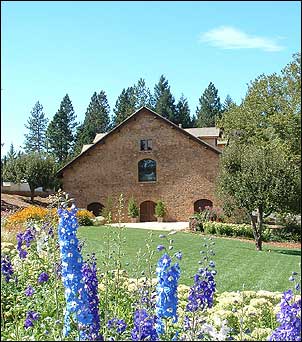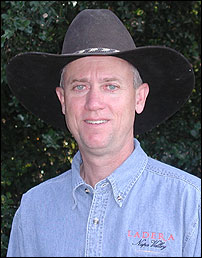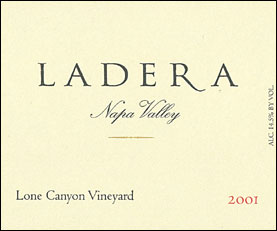

Howell Mountain ~ Napa Valley (AVA)
Ladera’s Appellation Distinctive Cabernets
“Top Hats and Stetsons” – Distinguishing appellations the Stotesbery way.
by
Alan Goldfarb
August 29, 2005
The passenger in the front seat of Pat Stotesbery’s SUV gets jostled to-and-fro as the car climbs and switches back and forth on the narrow road, and then continues to climb and climb some more.
The vintner, who came to the Napa Valley years ago from Montana to start Ladera Vineyards on Howell Mountain describes -- in what can only be termed Montanaisms -- his other vineyard he calls Lone Canyon, as “billy-goat steep.” And there are, “in back-of-the-napkin numbers,” about 50 blocks of vines that can be seen dotting the rugged landscape from horizon-to-horizon.
Stotesbery, with his winemaker Karen Culler, are now making two Cabernets under the Ladera label, one from Howell Mountain, and the other from Lone Canyon located high in the western hills above Yountville.
The two wines are easily differentiated. The Howell Cab is more elegant with much finesse, while the Lone Canyon wine is as big, closed and tannic as one would expect from such a rough-and-tumble terrain. The wines, when tasted side-by-side, are definitive examples of terroir.
Stotesbery bought the 480-acre box canyon in 1997. It is only about 15 percent planted, mostly to Cabernet. But he takes the notion of appellation characteristics further, with the practice of stenciling a top hat and a Stetson on the respective barrel-faces of the two wines.
The Howell Cab he calls “a gentleman,” while Stotesbery, who is almost always seen in his ubiquitous black wide-brim, terms the Lone Canyon wine “our cowboy.”
While he does produce a “Napa Valley” Cab ($35), which is a blend of the two vineyards, Stotesbery is steadfast about making wines that separate the place of origin. Thus, Culler makes a Howell Mountain-designate, and a Lone Canyon, both of which sell for $65.
“Some people love the elegance of the Howell Mountain and others the dark tannins of the Lone Canyon,” says Culler, who has been making wine for Ladera for seven years. “If you would blend them together, you’d lose that sense of place. It becomes another …”
“… Another blended wine,” Stotesbery chimes in, finishing her sentence.
He purchased Lone Canyon after he bought his first vineyard just across the canyon on Mt. Veeder (which he eventually sold) because “it reminded me of Montana,” he says. “The ruggedness of it and because it’s back so far. It felt rural, like Montana, but yet it was so close to civilization.”
So close, but so far. After leaving the valley floor at the entrance to the Veterans Home and to Domaine Chandon, one treks past Dominus and then above Blankiet to where the Lone Canyon vines -- some as old as 22 years -- cling to the hillside at elevations from 400 to 1,100 feet.
 The vineyard climbs and falls on inside and outside terraces that overlook, while still being in, the Yountville AVA. When questioned as to which appellation Lone Canyon belongs, Stotesbery seems loath to admit that indeed, it’s under Yountville’s purview.
The vineyard climbs and falls on inside and outside terraces that overlook, while still being in, the Yountville AVA. When questioned as to which appellation Lone Canyon belongs, Stotesbery seems loath to admit that indeed, it’s under Yountville’s purview.
When he was in the process of buying the parcel he explains, the demarcation line was being made all the way to Mt. Veeder in the final throes of the approval process, and apparently he had no say in its determination. The implication is that since his grapes are mountain grapes grown in the primarily valley floor region, Lone Canyon’s fruit is different from those in the rest of the AVA.
Perhaps that is why he does not allow the two producers who buy 20 percent of the fruit from Lone Canyon, to vineyard-designate the wine.
“I’ve been asked (to allow that), but I won’t let them,” he says. “If anyone screws it up, let me be the one who screws it up.”
That’s because the Cab and the small amounts of Malbec and Petit Verdot from there, are not easily tamed, nor understood. Even to Karen Culler.
“I’m still trying to figure it out,” she admits. “It makes a pretty big wine and it tends to get too tannic. They tend to be muscle-y wines (but) they don’t have as much extraction (as Howell Mountain).”
“The tannin structure is the biggest difference (between the two). Lone Canyon has dark, berry fruit and herbal characters, while the Howell has silky tannins and brighter fruit.”
Nevertheless, she says about the tannins in the Lone Canyon, “it’s not a bad thing. It’s much easier to hold it back than to try and get it out. (But) we just have to learn it.”
So, is it worth all the bother to get in and out of that canyon, with its axle-breaking topography and its rear-end impact?
“With the intensity of the fruit, I’d say it is,” Stotesbery concludes simply.
The vintner, who came to the Napa Valley years ago from Montana to start Ladera Vineyards on Howell Mountain describes -- in what can only be termed Montanaisms -- his other vineyard he calls Lone Canyon, as “billy-goat steep.” And there are, “in back-of-the-napkin numbers,” about 50 blocks of vines that can be seen dotting the rugged landscape from horizon-to-horizon.
Stotesbery, with his winemaker Karen Culler, are now making two Cabernets under the Ladera label, one from Howell Mountain, and the other from Lone Canyon located high in the western hills above Yountville.
The two wines are easily differentiated. The Howell Cab is more elegant with much finesse, while the Lone Canyon wine is as big, closed and tannic as one would expect from such a rough-and-tumble terrain. The wines, when tasted side-by-side, are definitive examples of terroir.
Stotesbery bought the 480-acre box canyon in 1997. It is only about 15 percent planted, mostly to Cabernet. But he takes the notion of appellation characteristics further, with the practice of stenciling a top hat and a Stetson on the respective barrel-faces of the two wines.

The Howell Cab he calls “a gentleman,” while Stotesbery, who is almost always seen in his ubiquitous black wide-brim, terms the Lone Canyon wine “our cowboy.”
While he does produce a “Napa Valley” Cab ($35), which is a blend of the two vineyards, Stotesbery is steadfast about making wines that separate the place of origin. Thus, Culler makes a Howell Mountain-designate, and a Lone Canyon, both of which sell for $65.
“Some people love the elegance of the Howell Mountain and others the dark tannins of the Lone Canyon,” says Culler, who has been making wine for Ladera for seven years. “If you would blend them together, you’d lose that sense of place. It becomes another …”
“… Another blended wine,” Stotesbery chimes in, finishing her sentence.
He purchased Lone Canyon after he bought his first vineyard just across the canyon on Mt. Veeder (which he eventually sold) because “it reminded me of Montana,” he says. “The ruggedness of it and because it’s back so far. It felt rural, like Montana, but yet it was so close to civilization.”
So close, but so far. After leaving the valley floor at the entrance to the Veterans Home and to Domaine Chandon, one treks past Dominus and then above Blankiet to where the Lone Canyon vines -- some as old as 22 years -- cling to the hillside at elevations from 400 to 1,100 feet.
 The vineyard climbs and falls on inside and outside terraces that overlook, while still being in, the Yountville AVA. When questioned as to which appellation Lone Canyon belongs, Stotesbery seems loath to admit that indeed, it’s under Yountville’s purview.
The vineyard climbs and falls on inside and outside terraces that overlook, while still being in, the Yountville AVA. When questioned as to which appellation Lone Canyon belongs, Stotesbery seems loath to admit that indeed, it’s under Yountville’s purview.
When he was in the process of buying the parcel he explains, the demarcation line was being made all the way to Mt. Veeder in the final throes of the approval process, and apparently he had no say in its determination. The implication is that since his grapes are mountain grapes grown in the primarily valley floor region, Lone Canyon’s fruit is different from those in the rest of the AVA.
Perhaps that is why he does not allow the two producers who buy 20 percent of the fruit from Lone Canyon, to vineyard-designate the wine.
“I’ve been asked (to allow that), but I won’t let them,” he says. “If anyone screws it up, let me be the one who screws it up.”
That’s because the Cab and the small amounts of Malbec and Petit Verdot from there, are not easily tamed, nor understood. Even to Karen Culler.
“I’m still trying to figure it out,” she admits. “It makes a pretty big wine and it tends to get too tannic. They tend to be muscle-y wines (but) they don’t have as much extraction (as Howell Mountain).”
“The tannin structure is the biggest difference (between the two). Lone Canyon has dark, berry fruit and herbal characters, while the Howell has silky tannins and brighter fruit.”
Nevertheless, she says about the tannins in the Lone Canyon, “it’s not a bad thing. It’s much easier to hold it back than to try and get it out. (But) we just have to learn it.”
So, is it worth all the bother to get in and out of that canyon, with its axle-breaking topography and its rear-end impact?
“With the intensity of the fruit, I’d say it is,” Stotesbery concludes simply.














